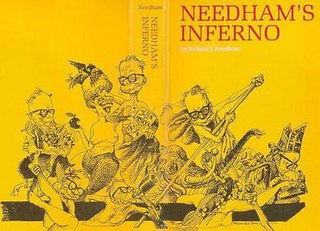
A cartoon is a type of visual art that is typically drawn, frequently animated, in an unrealistic or semi-realistic style. The specific meaning has evolved, but the modern usage usually refers to either: an image or series of images intended for satire, caricature, or humor; or a motion picture that relies on a sequence of illustrations for its animation. Someone who creates cartoons in the first sense is called a cartoonist, and in the second sense they are usually called an animator.

Benjamin Franklin Thorne was an American comic book artist-writer, best known for the Marvel Comics character Red Sonja.

Virgil Franklin Partch, who generally signed his work Vip, was an American gag cartoonist. His work appeared in magazines of the 1940s and 1950s, and he created the newspaper comic strips Big George and The Captain's Gig. He published 19 books of illustrations and drew art for children's books.

Little Annie Fanny is a comics series by Harvey Kurtzman and Will Elder. It appeared in 107 two- to seven-page episodes in Playboy magazine from October 1962 to September 1988. Little Annie Fanny is a humorous satire of contemporary American society and its sexual mores. Annie Fanny, the title character, is a statuesque, buxom young blonde woman who innocently finds herself nude in every episode. The series is notable for its painted, luminous color artwork and for being the first full-scale, multi-page comics feature in a major American publication.

Douglas Samuel Wildey was an American cartoonist and comic book artist best known for originally conceptualizing and co-creating the classic 1964 American animated television series Jonny Quest for Hanna-Barbera Productions.

Douglas Austin Wright was a Canadian cartoonist, best known for his weekly comic strip Doug Wright's Family. The Doug Wright Awards are named after him to honour excellence in Canadian cartooning.
Notable events of 2006 in comics.

Arnold Roth is an American cartoonist and illustrator for advertisements, album covers, books, magazines, and newspapers. Novelist John Updike wrote, "All cartoonists are geniuses, but Arnold Roth is especially so."
Robert London is an American underground comix and mainstream comics artist. His style evokes the work of early American cartoonists like George Herriman and Elzie Crisler Segar.
Glenn McCoy is a conservative American cartoonist, whose work includes the comic strip The Duplex and the daily panel he does with his brother Gary entitled The Flying McCoys. McCoy previously produced editorial cartoons until May 2018, when he refocused his career on animations after being discharged from his job of 22 years at the Belleville News-Democrat. All three cartoon features are syndicated by Andrews McMeel Syndication.

Duncan Ian Macpherson, CM was a Canadian editorial cartoonist. He drew for the Montreal Standard and for Maclean's, illustrating the writings of Gregory Clark and Robert Thomas Allen. He is most famous for his humorous political cartoons for the Toronto Star; from 1958 until 1993. His syndicated cartoons appeared in seven other Canadian newspapers, in Time, The New York Times, Chicago Daily News and nearly 150 newspapers across the world.

The Canadian Cartoonist Hall of Fame, formally known as Giants of the North: The Canadian Cartoonist Hall of Fame, honours significant lifelong contributions to the art of cartooning in Canada.
Geoffrey Raynor Hook was an Australian artist and editorial cartoonist.
Everett Lee Peck was an American illustrator, cartoonist, and animator, best known as the creator of the animated sitcom Duckman. He also created Squirrel Boy for Cartoon Network and was a character designer for an animated series adaptation of Jumanji.
Raymond Curtis Billingsley is an African American cartoonist, best known for creating the comic strip Curtis. It is distributed by King Features Syndicate and printed in more than 250 newspapers nationwide.

Sidney Arnold Barron was a Canadian editorial cartoonist and artist. During his career as a cartoonist, he drew for the Victoria Times, the Toronto Star, Maclean's, and The Albertan. His cartoons were satirical takes on social mores, and often contained a biplane towing a banner, and a bored-looking cat, holding a card bearing a wry comment. Later in life, Barron moved to Vancouver Island, where he and his wife opened an art studio and gallery.

Canadian comics refers to comics and cartooning by citizens of Canada or permanent residents of Canada regardless of residence. Canada has two official languages, and distinct comics cultures have developed in English and French Canada. The English tends to follow American trends, and the French, Franco-Belgian ones, with little crossover between the two cultures. Canadian comics run the gamut of comics forms, including editorial cartooning, comic strips, comic books, graphic novels, and webcomics, and are published in newspapers, magazines, books, and online. They have received attention in international comics communities and have received support from the federal and provincial governments, including grants from the Canada Council for the Arts. There are comics publishers throughout the country, as well as large small press, self-publishing, and minicomics communities.

Thomas Lewis Skuce, more popularly known as Lou Skuce, was a Canadian comic strip and editorial cartoonist, who also appeared widely in movie theatres to entertain while producing cartoons that were projected onto the screen. He also worked in commercial illustration, owning his own studio serving advertising clients in Canada and the United States. During World War II, he also produced material that appeared in the Canadian Whites. When he died, he was referred to as "Canada's Greatest Cartoonist".
Merle "Ting" Tingley was a Canadian cartoonist who was the main editorial cartoonist for the London, Ontario newspaper, The London Free Press, from 1948 to 1986 as well as being syndicated for 60 other publications as well.
Patrick Blower is a British editorial cartoonist and painter whose work appears predominantly in the Daily Telegraph where he is the current chief political cartoonist. In 2023 he won the Political Cartoon Society’s Award for Political Cartoonist of the Year. He uses Blower mononymously when signing his cartoons for publication.










